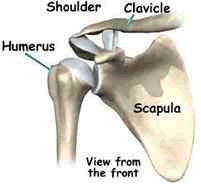|
About Shoulders
Your shoulder is the most movable joint in your body. This flexibility allows you to hit a backhand swing, stretch for a top shelf or lift heavy items. The shoulder also helps you position your hand for movements such as waving goodbye or using the mouse on your computer.
Most shoulder problems involve the shoulder's soft tissues: the tendons, ligaments or muscles. The bones also can be affected.
With this flexibility, however, can come injury - and a variety of painful problems. The shoulder consists of three bones:
. shoulder blade (scapula)
. collar bone (clavicle)
. upper arm bone (humerus).
Two main joints help your shoulder move easily:
. Commonly called the shoulder joint, the glenohumeral joint helps you move your shoulder forward and backward. It also enables your arm to rotate in a circular manner or move outward.
The glenohumeral joint is composed of the socket on your shoulder blade (glenoid) and the "ball" at the top of your arm bone (the humerus). Uniquely, the ball of the upper arm bone is twice the size of the shoulder blade socket.
One way of picturing this joint is to think of a golf ball on a tee.
. The acromioclavicular joint is located between your shoulder blade (acromion) and your collar bone (clavicle).
In addition, the sternoclavicular joint is a bridge between the upper extremity and the back of your rib cage (thorax).
Muscles, tendons and ligaments also support the shoulder joint. Four tendons make up what is called the rotator cuff.
This complex arrangement of bones, muscles, tendons and ligaments can be injured by an accident or overuse. Disease also can affect the shoulder. When that happens, the pain and lack of mobility can be severe enough to affect your ability to work and enjoy normal activities of daily life.
You do not have to live with shoulder pain or a lack of shoulder mobility and strength.

Common Problems
- Rotator Cuff Tears : Treatment of rotator cuff tears with shoulder arthroscopy is controversial. Some orthopedic surgeons treat all rotator cuff tears arthroscopically, some choose particular tears, and others treat them all open. There is no consensus which one is better.
- Shoulder Instability - Labral Tears - Slap Lesions Labral tears, such as Bankart lesions and SLAP tears, are commonly treated with arthroscopy. It is very important that patients who have arthroscopic surgery for these procedures follow their post-operative rehab protocol very closely. Patients are often tempted to do too much too soon!
- Impingement Syndrome : Patients with impingement syndrome that is not cured with conservative treatments may consider a procedure called an arthroscopic subacromial decompression. This procedure removes the inflamed bursa and some bone from the irritated area around the rotator cuff tendons. By removing this tissue, more space is created for the tendons and the inflammation often subsides.
- Biceps Tendonitis : The biceps tendon can become irritated and inflamed as an isolated problem or in association with problems such as impingement syndrome and rotator cuff tears. When the biceps tendon is damaged and causing pain, a procedure called a biceps tenodesis can be performed. This procedure usually causes no functional difference, but often relieves symptoms.
- Frozen Shoulder : Frozen shoulder seldom requires operative treatment, and treatment for many months or years is often necessary before considering operative treatment. When frozen shoulder must be treated surgically, it is of utmost importance to begin aggressive physical therapy immediately following surgery. Without this, it is likely the problem will return.
- AC Joint Arthritis : The AC joint, or acromioclavicular joint, is occasionally affected by arthritis. When arthritis of the AC joint is severe, the end of the clavicle (collarbone) can be removed. By removing the damaged joint, the symptoms of AC arthritis are often relieved.

First Aid in Shoulder Injuries
When it comes to treating your shoulder problem, there are a number of options. Your physician will counsel you on the best solution for your situation.
Start with RICE :
Here are steps to take when you first have shoulder pain, commonly called RICE.
. Rest - Reduce or stop using the injured area for 48 hours.
. Ice - Put an ice pack on the injured area for 20 minutes at a time, 4 to 8 times per day. Use a cold pack, ice bag, or plastic bag filled with crushed ice or frozen vegetables wrapped in a towel. (Never put ice directly on the affected area.)
. Compression - Compression may help reduce the swelling. Compress the area with elastic bandages.
. Elevation - Keep the injured area elevated above the level of your heart. You can use a pillow to help elevate the shoulder.
If pain and stiffness continue, call your doctor.
Use pain medications When you have a shoulder problem, pain is a constant reminder that something is wrong. Over-the-counter or prescription pain medication may help your symptoms. The pain medications usually are combined with substances that reduce inflammation (anti-inflammatories).
If pain persists or is severe, call your doctor.

Treatment Options
Coming Soon...

Recovery
The recovery depends on what type of surgery is performed. One of the problems with shoulder arthroscopy is that the procedure hurts much less than open shoulder surgery, and therefore patients may tend to do too much, too soon. It is very important that you only perform activities that your surgeon recommends following a shoulder arthroscopy. Even though your shoulder may feel fine, you need to allow time for repaired tissues to adequately heal. This is especially important for patients who have rotator cuff repairs and labral repairs.

Physical Therapy
Physical therapy involves activities to restore your shoulder's mobility and reduce pain. A physical therapist is a key part of your medical team, and will be involved in all phases of your shoulder's rehabilitation. Physical therapy may be a good solution to your shoulder problem. If your condition doesn't improve after a period of treatment, however, your physician may recommend surgery. Physical therapy will continue to be an integral part of your recovery after surgical treatment.

Advantages
Coming Soon...

Updates
Coming Soon...

|





